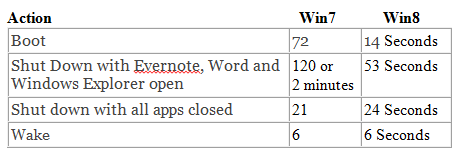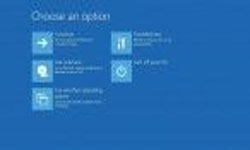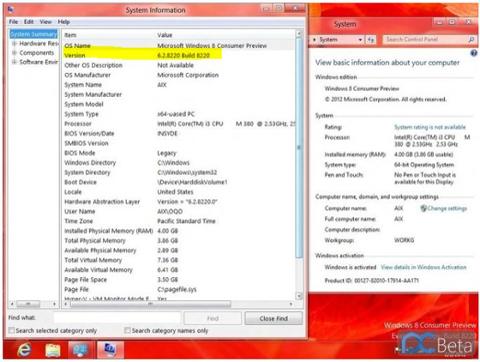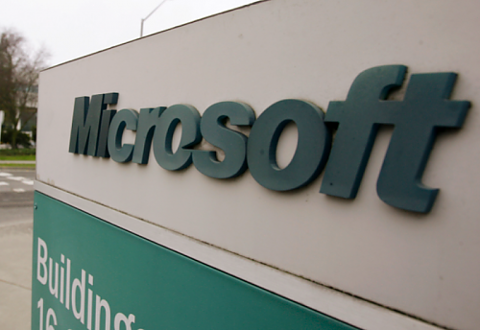All of Microsoft's ruckus about its brand spanking new
Windows 8 hides a basic truth: This is really two distinct operating systems sharing the same computer, and it's most obvious during boot.

A month ago, I upgraded an Asus Eee PC running Windows 7 Starter to Windows 8. When it boots I see the new Windows Logo, the login screen and then, for a split second, my old Windows 7 desktop and background before the Windows 8 background lays on top of that. That's two operating systems loading consecutively.
Hidden Frustrations
Does this matter? For the end user's point of view, it depends. They've lost the Start button, which isn't as trivial as it first seems. “Start” has been
the symbol of Windows since Windows 95 was introduced more than 17 years ago. For many computer users, Start is the only way they know to interact with a PC. They never used Windows 3.1 or NT 3.51, let alone DOS. Never mind that Apple had a similar launch button long before 1995. Redmond made the bigger deal out of it. People lined up around the block to buy the OS. (Was anyone in those days lining up like that for Apple?) The company whipped people up with a $300 million ad campaign that blasted the Rolling Stones singing
Start Me Up. (They alone cost between $8 and $14 million.) Be that as it may, because the Start button is irrelevant to tablets, it had to go. Sort of. It has to stay in some form because conventional Windows users who are still crunching documents with 32- and 64-bit apps need their mouse to navigate. Once their apps are launched they don't need to see Windows 8 tiles again -- but they still need to launch their apps.
Better Boot Speed
One glowing feature users immediately notice is how fast Windows 8 boots, wakes and shuts down. I'm watching a Windows 7 migration from XP right now and users are overjoyed with how much faster 7 is over XP. Windows 8 is considerably faster still. Before I upgraded my 2.5 year-old (dropped once) Asus Eee PC duel core Intel Atom 1.66GHz with 2MB RAM netbook, I timed how long Windows 7 needed to boot, wake and shut down. Then I timed again after an upgrade to Windows 8. This wasn't a benchmark. Just me being curious. Here's what I found:

Notice the shutdown was 3 seconds slower on Windows 8, but this really varies. Same since the days of W2K. Some days it was lightning, other days you could come back from a coffee break to see it finish mapping drives. Win 8 is not as resource intensive as Win7 because Microsoft removed Aero, which was a resource hog. Video cards don't need to render as much and Windows is snappier now. Once users feel comfortable they'll be just fine using the new tiles to start their old Windows 7 applications. They can toggle to the HTML 5 tiles to check the weather and their email without making a single click. Eventually, they'll probably spend more time in the Windows 8 side and see that they can do all their work there. As upgraded apps become available, they'll spend less and less time with Windows 7. A faster more responsive operating system combined with a lot of information with fewer clicks and a tablet that looks the same way will make even leery users comfortable over time.
The End is Near

The Windows 7 side of Windows 8 will likely be dropped in the next release (Windows 9?). By then Microsoft will have surely have weaned its multitude of users from its desktop OS to its tablet/netbook OS. Microsoft is looking at the long game. People will still be working in the enterprise, but they won't be using desktops in the conventional sense. Ironically, I can't help but think that if Microsoft hadn't adopted the Start button in the first place and continued to pursue tiles, it might have gotten to Windows 8's distinct approach a lot sooner.
 A month ago, I upgraded an Asus Eee PC running Windows 7 Starter to Windows 8. When it boots I see the new Windows Logo, the login screen and then, for a split second, my old Windows 7 desktop and background before the Windows 8 background lays on top of that. That's two operating systems loading consecutively.
A month ago, I upgraded an Asus Eee PC running Windows 7 Starter to Windows 8. When it boots I see the new Windows Logo, the login screen and then, for a split second, my old Windows 7 desktop and background before the Windows 8 background lays on top of that. That's two operating systems loading consecutively.
 Notice the shutdown was 3 seconds slower on Windows 8, but this really varies. Same since the days of W2K. Some days it was lightning, other days you could come back from a coffee break to see it finish mapping drives. Win 8 is not as resource intensive as Win7 because Microsoft removed Aero, which was a resource hog. Video cards don't need to render as much and Windows is snappier now. Once users feel comfortable they'll be just fine using the new tiles to start their old Windows 7 applications. They can toggle to the HTML 5 tiles to check the weather and their email without making a single click. Eventually, they'll probably spend more time in the Windows 8 side and see that they can do all their work there. As upgraded apps become available, they'll spend less and less time with Windows 7. A faster more responsive operating system combined with a lot of information with fewer clicks and a tablet that looks the same way will make even leery users comfortable over time.
Notice the shutdown was 3 seconds slower on Windows 8, but this really varies. Same since the days of W2K. Some days it was lightning, other days you could come back from a coffee break to see it finish mapping drives. Win 8 is not as resource intensive as Win7 because Microsoft removed Aero, which was a resource hog. Video cards don't need to render as much and Windows is snappier now. Once users feel comfortable they'll be just fine using the new tiles to start their old Windows 7 applications. They can toggle to the HTML 5 tiles to check the weather and their email without making a single click. Eventually, they'll probably spend more time in the Windows 8 side and see that they can do all their work there. As upgraded apps become available, they'll spend less and less time with Windows 7. A faster more responsive operating system combined with a lot of information with fewer clicks and a tablet that looks the same way will make even leery users comfortable over time.
 The Windows 7 side of Windows 8 will likely be dropped in the next release (Windows 9?). By then Microsoft will have surely have weaned its multitude of users from its desktop OS to its tablet/netbook OS. Microsoft is looking at the long game. People will still be working in the enterprise, but they won't be using desktops in the conventional sense. Ironically, I can't help but think that if Microsoft hadn't adopted the Start button in the first place and continued to pursue tiles, it might have gotten to Windows 8's distinct approach a lot sooner.
The Windows 7 side of Windows 8 will likely be dropped in the next release (Windows 9?). By then Microsoft will have surely have weaned its multitude of users from its desktop OS to its tablet/netbook OS. Microsoft is looking at the long game. People will still be working in the enterprise, but they won't be using desktops in the conventional sense. Ironically, I can't help but think that if Microsoft hadn't adopted the Start button in the first place and continued to pursue tiles, it might have gotten to Windows 8's distinct approach a lot sooner. 


